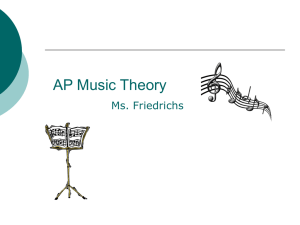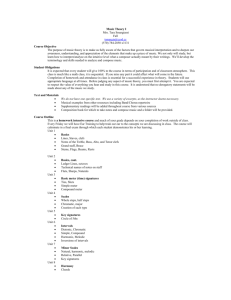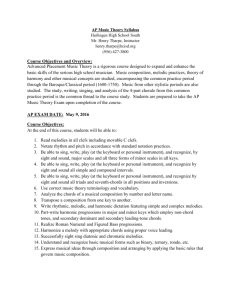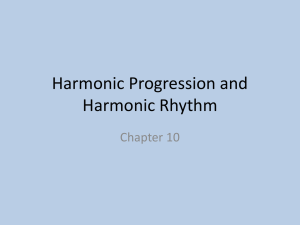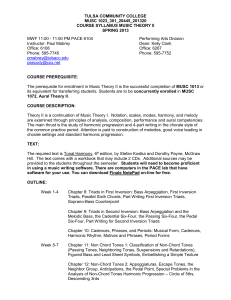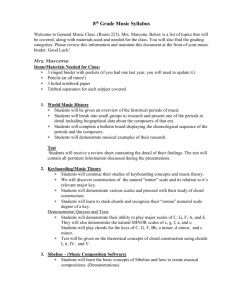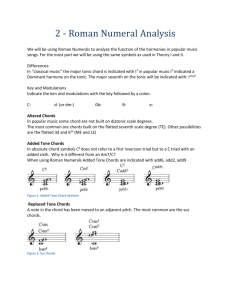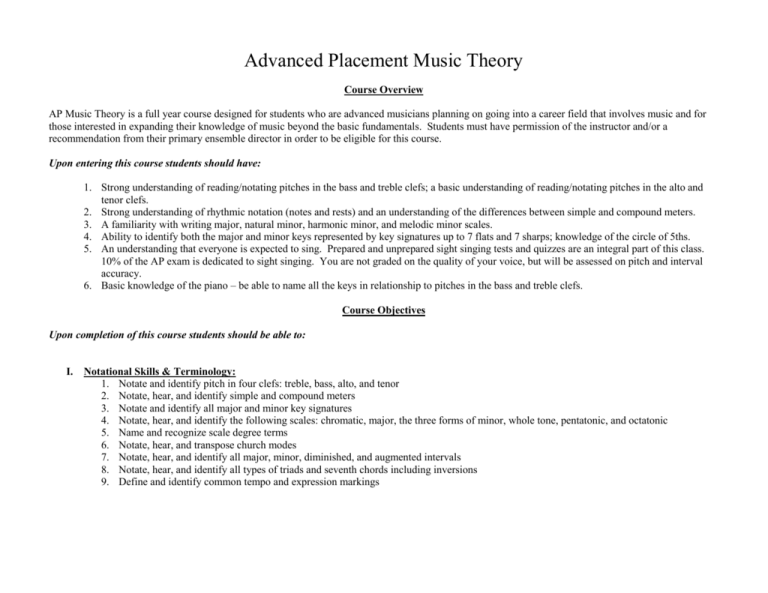
Advanced Placement Music Theory
Course Overview
AP Music Theory is a full year course designed for students who are advanced musicians planning on going into a career field that involves music and for
those interested in expanding their knowledge of music beyond the basic fundamentals. Students must have permission of the instructor and/or a
recommendation from their primary ensemble director in order to be eligible for this course.
Upon entering this course students should have:
1. Strong understanding of reading/notating pitches in the bass and treble clefs; a basic understanding of reading/notating pitches in the alto and
tenor clefs.
2. Strong understanding of rhythmic notation (notes and rests) and an understanding of the differences between simple and compound meters.
3. A familiarity with writing major, natural minor, harmonic minor, and melodic minor scales.
4. Ability to identify both the major and minor keys represented by key signatures up to 7 flats and 7 sharps; knowledge of the circle of 5ths.
5. An understanding that everyone is expected to sing. Prepared and unprepared sight singing tests and quizzes are an integral part of this class.
10% of the AP exam is dedicated to sight singing. You are not graded on the quality of your voice, but will be assessed on pitch and interval
accuracy.
6. Basic knowledge of the piano – be able to name all the keys in relationship to pitches in the bass and treble clefs.
Course Objectives
Upon completion of this course students should be able to:
I. Notational Skills & Terminology:
1. Notate and identify pitch in four clefs: treble, bass, alto, and tenor
2. Notate, hear, and identify simple and compound meters
3. Notate and identify all major and minor key signatures
4. Notate, hear, and identify the following scales: chromatic, major, the three forms of minor, whole tone, pentatonic, and octatonic
5. Name and recognize scale degree terms
6. Notate, hear, and transpose church modes
7. Notate, hear, and identify all major, minor, diminished, and augmented intervals
8. Notate, hear, and identify all types of triads and seventh chords including inversions
9. Define and identify common tempo and expression markings
II. Compositional Skills:
1. Compose a bass line for a given melody to create simple two-part counterpoint in 17th and 18th century style; analyze implied harmonies
2. Realize a figured bass according to the rules of 18th century chorale style in a major or minor key using any or all of the following devices;
diatonic triads and seventh chords, inversions, non-harmonic tones, secondary dominants, and dominant seventh chords
3. Realize a four-part chorale style progression from Roman numerals
III. Score Analysis:
1. Notate, hear, and identify perfect authentic, imperfect authentic, plagal, half, Phrygian half, and deceptive cadences in major and minor keys
2. Identify within a score the following non-harmonic tones: passing tone, (accented and unaccented), neighbor tone, anticipation, suspension,
retardation, appoggiatura, escape tone, changing tone (echapee and cambiata), and pedal tone.
3. Small-scale and large-scale harmonic procedures, including
A. Identification of cadence types
B. Roman numeral and figured bass analysis, including non-harmonic tones, seventh chords, and secondary dominants
C. Identification of key centers and key relationships; recognition of modulation to closely related keys
4. Melodic organization and developmental procedures:
A. Scale types; modes
B. Melodic patterning
C. Motivic development and relationships (ie:inversion, sequence, retrograde, imitation)
5. Rhythmic/Metric Organization
A. Meter type and beat type (ie: duple, triple, compound, irregular)
B. Rhythmic devices and procedures (ie: augmentation, diminution, hemiola)
6. Texture
A. Types: monophonic, homophonic, polyphonic, heterophonic, melody w/accompaniment
B. Devices: textural inversion, imitation
7. Form
A. Binary, Ternary, Rounded Binary, Rondo, Theme and Variation, Sonata
IV. Aural Skills:
1. Detect pitch and rhythm errors in written music from given aural stimulus
2. Notate a melody from dictation, 6 to 8 bars, major key, mostly diatonic pitches, simple or compound time, treble or bass clef, 3 to 4
playings
3. Notate a melody from dictation, 6 to 8 bars, minor key, chromatic alteration from harmonic/melodic minor scales, simple or compound
time, treble or bass clef, 3 to 4 playings
4. Sight sing a melody, 4 to 8 bars, major or minor key, duple or triple meter, simple or compound time, treble or bass clef, using solfege, pitch
names, numbers, or any comfortable vocal syllable
5. Hear the following non-harmonic tones: passing tone, neighboring tone, anticipation, suspension, retardation, appoggiatura, escape tone,
changing tone, and pedal tone
6. Notate the soprano and bass pitches in Roman numeral analysis of a harmonic dictation in 18th century style to include 7th chords, secondary
dominants, major or minor key, 3 to 4 playings
7. Identify processes and materials in the context of music literature representing a broad spectrum of genres, media, and styles:
A. Melodic organization (scale-degree function of specified tones, scale types, modes, melodic patterning, sequences, motivic
development)
B. Harmonic organization (chord function, quality, inversion)
C. Tonal organization (cadence types, key relationships)
D. Meter and rhythmic patterns
E. Instrumentation (identification of timbre)
F. Texture (number and position of voices, amount of independence, presence of imitation, density)
G. Formal procedures (phrase structure, distinctions among literal repetition, varied repetition, and contrast; small forms)
Keyboard Skills:
The students will develop and demonstrate the following keyboard skills:
Major Scales
Minor Scales (Three Forms)
Modes
Triads (M, m, o, +) with Inversions
Seventh Chords; MM, Mm, mm, om, oo with inversions
Chord Progression: I – IV – V7 – I in all keys Major and minor
Text:
Clendinning, Jane Piper and Elizabeth West Marvin, The Musician’s Guide To Theory and Analysis, W.W. Norton & Company, Inc.
Ottman, Robert and Nancy Rogers, Music for Sight Singing, 7th edition, Pearson Prentice Hall
In addition to the use of the text books listed above, the following sources will be utilized;
1. Recordings of musical performances
2. Online resources, i.e. www.music theory.net, www.teoria.com etc.
3. Self-generated materials:
a. Original worksheets on staff paper
b. Worksheets from Finale
c. Supplementary materials provided by David Lockart, instructor of AP Music Theory Teacher’s Training Course
d. Musical examples and compositions
i. From a variety of sources, including Norton Anthology, Burkhardt Anthology
e. Aural Skills stimuli
i. From a variety of sources, including self generated, and resources by David Lockart
4. Worksheets available on line from sites such as the DiBenedietti web site
5. Various musical scores, including those from anthologies (see 3. c. above) and repertoire from hymnal, choral library, and variety of vocal and
instrumental scores.
Grading Policy:
Grades will be determined with the following categories and weighting:
Tests/Quizzes
Homework/Projects
Participation
40%
40%
20%
Homework must be shown to be completed on the day it is due. Late assignments will be penalized 10% for each day late. If a student is not in class the
day an assignment is due, it will be expected at the beginning of the next class period.
Tests and Quizzes missed due to an excused absence must be made up by the student within a week on the student’s own time. It is the responsibility of the
student to arrange this with the teacher. Tests, quizzes and homework missed due to an unexcused absence will receive no credit.
A grade on participation will be given each term based on the student’s daily engagement in classroom activities. Adherence to basic classroom rules and
basic rules of etiquette must be followed to maximize this portion of a student’s grade.
Syllabus
Advanced Placement Music Theory
***Readings are from Musician’s Guide To Theory and Analysis by Jane Piper Clendinning and Elizabeth West Marvin.
***It should understood that dictation skills are cumulative and that exercises listed in the corresponding column below are listed at the point that they are added to the process.
***Sightreading will be practiced daily from Music for Sight Singing by Robert Ottman and Nancy Rogers from the Chapters listed below.
Month/
Week
September
Week 1
Week 2
Week 3
Week 4
Key Concepts
Reading
Analysis &
Aural Analysis
Notation, Rhythm and
Meter, Scales and Key
Signatures, Intervals,
Dynamics, Tempo
Staff, Grand Staff, Clef
(Treble, Bass, C), Keyboard,
Chromatic Signs, Enharmonic
Equivalents, Leger Lines,
Octave ID.
Chapter 1
Assessments
Nightly homework will
be assigned from
instructor generated
handouts and use of the
“Try It” sections of the
text. In addition, the
projects in this column
will be assigned.
Sightreading
(Daily from
Ottman)
Chapter 1
Lennon/McCartney,
“Eleanor Rigby”
from Revolver
Beat,
Simple/Compound/Irregular
Meter, Note anatomy, Ties,
Dots, Slurs, Triplets, Duplets,
Rules of Musical Notation,
Syncopation, Rests, Tempo
terms grave to presto and
Dynamic markings ppp ~ fff.
Accents and other articulate
markings.
Chapters 2, 5,
10
Whole/Half step intervals,
Major and Minor scales and
related key signatures, Natural,
Harmonic and Melodic minor
scales. Parallel and Relative
Keys, Circle of Fifths, Modal
Scales, Pentatonic Scale,
Whole Tone Scale. Solfege.
Chapters 3
and 4
Intervals: Perfect, Major,
Minor, Augmented,
Diminished. Interval
inversions, Compound
Intervals
Bach, Brandenburg
Concerto No. 4,
second movement.
Homework/
Projects
Sousa, “The Stars
and Stripes Forever”
Joplin, “Pine Apple
Rag”
“Greensleeves” (folk
tune)
Webern, Variations
for Piano, Op. 27,
second movement.
Mozart, Piano Sonata
in C Major, K. 545,
first movement.
Creation of an
original 3-Part
Rhythmic
Composition – 8
Measures
Quiz on
Dynamic
markings
Unit Test on
chapters
1,2,5,10
Chapter 1
Chapter 2
Chapter 2
Chapter 6
Gershwin,
“S’Wonderful!”
Handel, Chacone in
G Major, from Trois
Lecons.
Quiz on Key
Signatures/Circl
e of Fifths.
Dictation
(Daily, Instructor
Generated)
Introduction of basic
rhythmic patterns in simple
and compound meters
Two measure rhythmic
examples in simple and
compound meter
Pitch patterns of three and
four diatonic pitches in
major and harmonic minor
keys
Pitch patterns of three and
four pitches not associated
with a specific tonal center.
Month/
Week
Key Concepts
October
Chords (Triads: M, m,
+, 0; Seventh chords:
MM, Mm, mm, 0m, oo),
Chord Inversions,
Figured Bass intro,
Scale degree names,
Roman numeral
analysis I. Beginning
Melody writing.
Transposition
Week 1
Chords: Triads and
Inversions of Triads.
Seventh chords and
Inversions.
Reading
Week 3
Week 4
Roman numeral
analysis of Triads and
Seventh chords (Root
Position and Inversion)
Beginning Melody
writing and
Transposition.
Assessments
Sightreading
(Daily from
Ottman)
Dictation
(Daily, Instructor
Generated)
Chapter 7
Lead Sheet and Popular
Music Symbols/Lead
Sheets. Chord charts
for major and minor
keys.
Introduction to Figured
Bass and Scale Degree
names.
Homework/
Projects
Nightly homework will
be assigned from
instructor generated
handouts and use of the
“Try It” sections of the
text. In addition, the
projects in this column
will be assigned.
Chapter 7
Week 2
Analysis &
Aural Analysis
Mozart, “Voi, che
sapete,” from The
Marriage of
Figaro”
Analysis of
Popular Music
excerpt
Van Heusen and
Burke, “Here’s
That Rainy Day,”
from Carnival in
Flanders.
pp. 244-249;
review pp. 5051
pp. 188-195,
p.321
Bach, “Ach Gott,
vom Himmel sieh’
darein” (Chorale
No. 253)
Bach, Cantata No.
140, (“Wachet
auf”), second
movement.
Bach, “O Haupt
voll Blut und
Wunden” (Chorale
No. 74)
Unit Test on
chapters
3,4,6
Quiz on Triad
Spelling
Analysis of Bach
Chorale
Sightreading
Quiz #1
Chapter 3
Chapter 3
Chapter 4
Creation of original
melodies for given
figured bass lines
Realization of
Figured bass lines.
Quiz on Chord
Charts/Scale
Degree names
Chapter 4
Two measure melodies.
Major keys/simple meter.
Root position triads
Two measure melodies.
Major keys/compound
meter. Triads in inversions
Two measure melodies.
Minor keys/simple meter.
Seventh Chords Root
position.
Two measure melodies.
Minor keys/compound
meter. Seventh Chords in
inversions.
Month/
Week
Key Concepts
November
Voice Leading,
Dominant Seventh
Chord, The 6/4
Chord, Cadences,
Non Harmonic Tones.
Week 1
Rules of four part voice
leading based in
common-practice
tonality. Chord
Doubling. Smooth
voice leading
techniques. Conjunct
and Disjunct Motion
Week 2
Week 4
The Dominant Seventh
Chord. Voicing and
Resolution. The 6/4
Chord and its use
Reading
Analysis &
Aural Analysis
Homework/
Projects
Assessments
Sightreading
(Daily from
Ottman)
Nightly homework will
be assigned from
instructor generated
handouts and use of the
“Try It” sections of the
text. In addition, the
projects in this column
will be assigned.
Chapter 14
pp 204 – 210,
pp. 260-275
Bach, Various
Chorales.
Mozart, Piano
Sonata in D Major,
K. 284, third
movement.
Composition: Root
position SATB
writing on given
Roman Numeral
progressions
Project: Identify and
submit examples of
each of the textures
from students own
listening library.
Unit test on
Chapter 7,
Figured bass,
Roman numeral
analysis and
transposition
Quiz on rules of
voice leading
Chapter 5
pp 536-538
and pp 211214. pp 299308
Bach, Various
Chorales.
Purcell, “Music for
a While”
Bach, Invention in
D minor.
Creation of an
original 16 bar
homophonic
composition
Moderate four measure
melodic examples. Scale
and Mode identification.
Two Part (Soprano/Bass) in
Major keys
Chapter 5
Sightreading
Quiz #2
Chapter 6
Texture (Monophonic,
Homophonic,
Polyphonic, Heterphonic)
Cadences (Authentic,
Plagal, Half, Deceptive,
Phrygian Half)
Non Harmonic Tones
(Passing, Neighboring,
Anticipation,
Appoggiatura, Pedal,
Double
Neighboring/Changing,
Escape, Suspension,
Retardation.)
Dictation
(Daily, Instructor
Generated)
Unit Test on
Voice
Leading, The
Dominant
Seventh Chord
Texture and
Non Harmonic
Tones.
Two Part (Soprano/Bass) in
Minor keys
Month/
Week
December
Week 1
Week 2
Week 3
Week 4
Key Concepts
Reading
Analysis &
Aural Analysis
Assessments
Sightreading
(Daily from
Ottman)
Dictation
(Daily, Instructor
Generated)
Nightly homework will
be assigned from
instructor generated
handouts and use of the
“Try It” sections of the
text. In addition, the
projects in this column
will be assigned.
Chromaticism/Secondary
Dominant/Leading Tone
Chords. Harmonic
Progression. Chord
Substitution. Species
Counterpoint, Cantus
Firmus
Chromaticism.
Secondary
Dominant/Leading
Tone Chords (Mm 7th
chords and Diminshed
7th Chords) in Major
and Minor Keys.
Chapter 21
Chord Substitution.
Altered Chords.
Harmonic Progression
(Pre-dominant,
Dominant and Tonic)
Chapter 16
Species I and II
Counterpoint
Cantus Firmus
Chapter 8
Four-part realization of
Cadences in SATB
from Roman numerals
Homework/
Projects
Bach, “Es ist
gewisslich an der
Zeit” (Chorale No.
260)
Hensel, “Neue
Liebe, neues
Leben”
Creation of an
original SATB
style composition
using inversions
of chords
Quiz on
Secondary
Dominant/
Leading Tone
Chord Spelling
Chapter 6
Recognition of chord quality.
Cadences. (Roman numeral)
Chapter 7
Harmonic Progressions
focused on Cadences from
both Keyboard and
Recordings. (Primary Chords
- Roman numeral)
Sightreading
Quiz #3
Mozart, Variations
on “Ah, vous diraije, Maman,”
Theme
Bach, “Ein feste
Burg ist unser
Gott”
Bach, Various
Chorales
Creation of an
original Cantus
Firmus followed
by Species I and
II counterpoint
Quiz on Species
I and II
counterpoint
rules
Chapter 8
Unit Test on
Chapters 8, 16,
21.
Chapter 8
Month/
Week
Key Concepts
January
Melody: Phrase
Forms, Period,
Antecedent/Conseque
nt, Motive. Sequence.
Melodic Composition,
Harmonization of
melodies.
Week 1
Week 2
Week 3
Week 4
Reading
Harmonization of given
and original melodies
Realization of Four
Part Roman Numeral
Progression.
Homework/
Projects
Assessments
Sightreading
(Daily from
Ottman)
Dictation
(Daily, Instructor
Generated)
Nightly homework will
be assigned from
instructor generated
handouts and use of the
“Try It” sections of the
text. In addition, the
projects in this column
will be assigned.
Phrase Forms, Motive, pp308-349
Period(Parallel/Contras
ting/Double), Phrase
Shape
Antecedent/Consequent
, Sequence
Melodic Composition.
Compositional devices
(ornamentation,
inversion,
augmentation,
diminution)
Analysis &
Aural Analysis
Supplementary
Handouts
Willson, “Till
There Was You”
from The Music
Man”
Foster, “Oh!
Susanna”
Aural analysis of
musical example
identifying
melodic devices
and structure.
Chapter 9
Mozart, Piano
Sonata in C Major,
K. 545, first
movement.
Bach, Invention in
D minor
Bach, Various
Chorales
Creation of original
Homophonic
Composition
featuring phrase
development and
Secondary Chord(s)
Sightreading
Quiz #4
Chapter 9
Unit Test on
Melodic
devices.
Chapter 10
Chapter 11
Harmonic Progressions with
increasing difficulty
including Secondary
function chords
Month/
Week
February
Week 1
Week 2
Week 4
March
Key Concepts
Analysis &
Aural Analysis
Modulation
(Phrase/Direct, Pivot,
Common Chord,
Chromatic,
Enharmonic)
Binary Form/Rounded
Binary
Ternary Form, Strophic
Chapter 22
Week 2
Theme and Variations
Week 3
Sonata Form/Sonantina
(Repeat, Da Capo,
Segno, Fine)
Ground Bass and
Through Composed
Clementi, Sonatina
in C Major, Op.
36, No. 1, first
movement.
Assessments
Quiz on
Modulation
Schubert, “Nur
wer die Sehnsucht
kennt”
Creation of original
pp.441-451
pp. 452 – 456
Larger Forms: Rondo,
Theme and Variations,
Sonata Form, Sonatina.
Ground Bass. Through
Composed
Rondo
Homework/
Projects
Sightreading
(Daily from
Ottman)
Nightly homework will
be assigned from
instructor generated
handouts and use of the
“Try It” sections of the
text. In addition, the
projects in this column
will be assigned.
Modulation, Small
Forms
(Binary,Rounded
Binary, Ternary,
Strophic)
Week 1
Week 4
Reading
Mozart, Piano
Sonata in D Major,
K. 284, third
movement
Beethoven, piano
Sonata in C minor,
Op. 13, second
movement.
Chapter 27
Chapter 28
pp. 527-528
Short Melodic
Compositions in each of
the small forms
Schubert,
“Erlkonig”
Purcell, Dido’s
Lament
Sightreading
Quiz #5
Preparation for the AP
Examination using examples
from past FR 1 and 2
Questions
Harmonic Chord Progression
examples with increasing
difficulty.
Unit Test on
Small Forms
Nightly homework will
be assigned from
instructor generated
handouts and use of the
“Try It” sections of the
text. In addition, the
projects in this column
will be assigned.
Mozart, Variations
on “Ah, vous diraije, Maman,”
Clement, Sonatina
Op. 36, No. 3
Chapter 12
Dictation
(Daily, Instructor
Generated)
Sightreading
Quiz #6
Creation of original
Short Melodic
Compositions in each of
the large forms
Unit Test on
Large Forms
Chapter 13
Preparation for the AP
Examination using examples
from past FR 3 and 4
Questions
Harmonic Chord Progression
examples with increasing
difficulty.
Month/
Week
Key Concepts
April
18th Century
Counterpoint
(Imitation, Canon,
Invention, Fugue) 20th
Century scales,
chordal structures
and compositional
techniques. Exam
Preparation.
Week 1
Imitation, Canon,
Invention, Fugue
Week 2
Sets, Set Classes,
Serialism, Twelve Tone
Rows
Week 4
May
Week 1
Reading
Analysis &
Aural Analysis
Homework/
Projects
Sample Test Questions
Week 3
Film Scoring
Week 4
Film Scoring
Sightreading
(Daily from
Ottman)
Dictation
(Daily, Instructor
Generated)
Nightly homework will
be assigned from
instructor generated
handouts and use of the
“Try It” sections of the
text. In addition, the
projects in this column
will be assigned.
Chapter
32,33,34
Bach, Passacaglia
and Fugue in d
minor
Schoenberg, Three
Piano Pieces
Webern, String
Quartet, Op. 5,
third movement
Creation of
original matrix
and twelve tone
row composition.
Analysis of a
Bach
Invention.
Chapter 14
Chapter 15
Study of
musical score
from the
movie
“Glory”
Study of the art of
Film Scoring,
followed by creation
of an original score to
accompany a scene
from a movie.
Preparation for the AP
Examination using examples
from past FR 1-4 Questions
Harmonic Chord Progression
examples with increasing
difficulty.
Sightreading
Quiz #7
AP Free Response
Preparation
Exam Preparation,
Post-Test
Compositional
Projects
Free Response
Questions
Week 2
Assessments
Month/
Week
June
Week 1
Week 2
Key Concepts
Reading
Analysis &
Aural Analysis
Homework/
Projects
Assessments
Sightreading
(Daily from
Ottman)
Post-test
Compositional
Projects
Continued work
on and
presentation of
film score.
Chapter 16
Dictation
(Daily, Instructor
Generated)

